Implementing Topic Clustering and Keyword Mapping

How to optimize multi-page content
If you have been learning SEO, you might have heard about the two key approaches: Topic Clustering and Keyword Mapping.
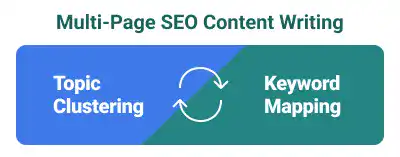
Both approaches are discussed when we optimize multi-page content, but they are used in slightly different contexts.
Topic clustering is a content strategy often used to structure multiple pages.
Keyword mapping is the process of assigning keywords to each web page.
When you optimize multi-page content, you cannot implement these two approaches separately.
There will be several iterations that involve the two approaches.
The following sections will explain how each approach helps you optimize multi-page content.
Topic clustering – pillar page and cluster pages
Topic clustering is a content organization strategy that involves grouping related pieces of content based on their semantic relevance, and interlinking them.
The main idea behind topic clustering is establishing topical authority by providing comprehensive coverage of a subject and signaling the depth and breadth of knowledge to search engines.
By organizing content into clusters and aligning with user intent and search engine algorithms, websites can enhance their visibility in search results, increase user engagement, and improve overall SEO performance.
When you implement topic clustering for your website or blog posts, you need to manage the following three control points:
- Pillar page
- Cluster pages
- Internal links
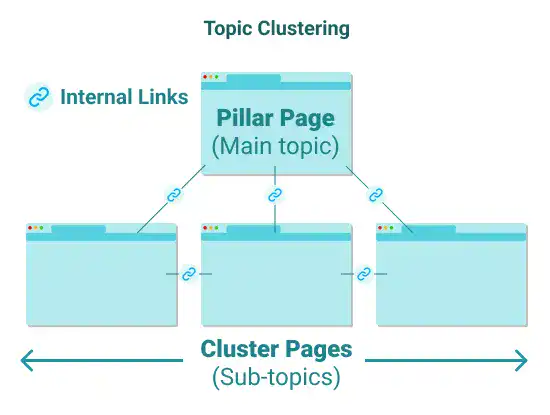
Pillar page
A pillar page on a website comprehensively covers content about a specific topic or theme; it can also have the form of an aggregation of blog posts. The pillar page covers all essential aspects of the theme and provides links to narrower subtopics within the same theme.
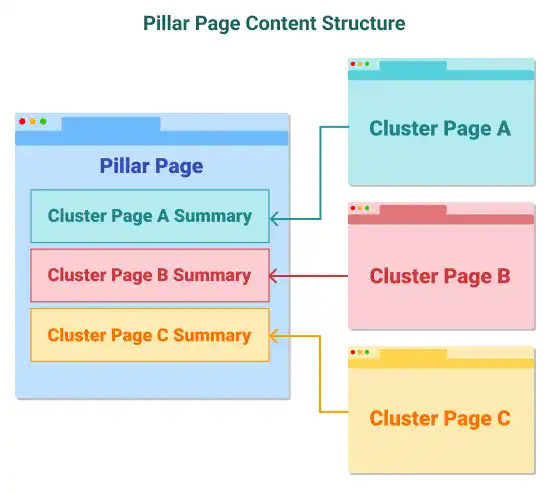
Cluster pages
Cluster pages are individual content pieces linked to a pillar page. They provide more detailed information on specific subtopics related to the main topic (theme), contributing to the content's overall depth and breadth.
Internal links
Internal links are crucial in topic clustering, connecting the pillar page and cluster pages, and establishing a hierarchical relationship.
Internal links help search engines understand content relevance and structure, improve crawlability and indexability, enhance user navigation between related topics, and strengthen topical authority for a website's target theme.
How to implement topic clustering
To implement topic clustering, you can follow these steps:
- Design topic hierarchy: Under the target theme, you need to group key topics and structure them. If you have enough in-depth topic knowledge, you can also design multi-layer topic clustering using a pyramid structure.
- Create a pillar page (or pillar pages): A pillar page should consist of summaries of cluster pages. As it covers the theme comprehensively, the content can be longer. If you apply multi-layer topic clustering, there will be a main pillar and sub-pillar pages.
- Create cluster pages: Elaborate specific subtopics related to the pillar topic (theme) and create cluster pages for each subtopic.
- Build internal links: Establish internal links between cluster pages and their respective pillar page for clear connection and navigation. You should ensure that the cluster pages are linking back to the related pillar pages to build two-way links.
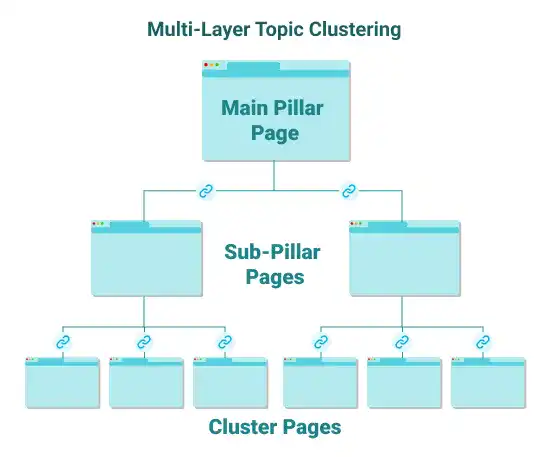
To optimize topic clusters from the SEO point of view, you also need to follow the keyword mapping approach explained in the next section.
Your topic clustering draft may impact keyword cannibalization. In that case, you need to refine your topic clusters.
To understand topic clustering better, you can read these articles.
- Topic Clusters for SEO: What They Are & How to Create Them
- What Is a Pillar Page? (And Why It Matters For Your SEO Strategy)
- How to Create Pillar Pages for SEO (With Examples!)
Keyword mapping – avoiding keyword cannibalization
Keyword mapping is the process of assigning specific target keywords to individual pages on a website.
The key idea of keyword mapping is to set a unique keyword for each page and ensure that the pages will not be cannibalized.
By nature, keywords for pillar pages tend to be short-tail or mid-tail keywords, while keywords for cluster pages are long-tail or mid-tail keywords.
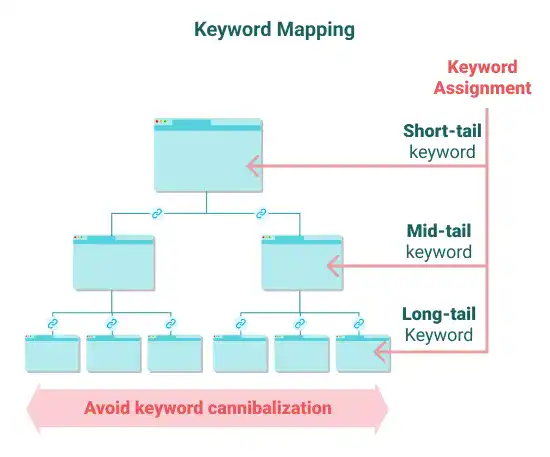
Integrating the keyword mapping process into the topic clustering approach
The keyword mapping approach is effective when implemented along with the topic clustering approach, although these two approaches are often explained separately.
The illustration below conceptually describes how to integrate the two approaches.
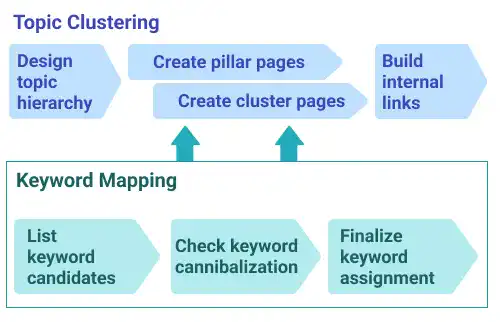
At a high level, there are three key steps in keyword mapping.
- Step1. List keyword candidates for each topic cluster page and the pillar page
- Step2. Check the pages for keyword cannibalization
- Step3. Finalize keyword assignment
How to check for keyword cannibalization
Checking for potential keyword cannibalization is critical for keyword mapping.
You can use search engines to check how your keywords are cannibalizing. Here are the simple steps:
- First, identify keywords that may potentially be cannibalized
- Search the keywords using a search engine and check the top 10 ranking search results on the SERP (Search Engine Result Page).
- If the top 10 search results for the keywords you identified are similar, those keywords are likely cannibalizing.
To understand keyword mapping better, you can read these articles.
- Keyword Mapping for SEO: Guide + Free Template
- Keyword Mapping: A Beginner’s Guide
- Keyword Mapping for SEO: How To Do It + Free Template
Tips: Technical considerations when you design a website
You may need to rearrange your website architecture (or blog post structure) if you have multiple pages or blog posts for the same theme and haven't done any SEO work. When you rearrange your website architecture, you should also consider improving general user experience (usability) and crawlability from a technical point of view.
Here are additional technical aspects you should consider on top of the topic clustering and keyword mapping approaches:
Canonicalization
Canonicalization is the process of selecting the preferred URL version when multiple URLs have similar or identical content. Canonicalization helps avoid not only duplicate content issues but also keyword cannibalization.
Combining pages and 301 redirect
If you have pages covering similar topics and creating keyword cannibalization, consider combining those pages. As you might have backlinks on the existing pages and built some good reputations with crawlers, you should carry them over to the new combined page.
301 redirect is the technique used to let crawlers know the original page has moved to another location, so they can match the backlinks and reputation of the old page to the new page.
Navigation bar
Having a navigation bar improves both usability and crawlability. With a navigation bar, users can quickly move to other website pages with minimum clicks. It also helps users understand website content layout easily. A navigation bar also improves the internal linking structure, improving crawlability.
Breadcrumbs
Having breadcrumbs is recommended for SEO. There are two types of breadcrumbs.
One is HTML-based breadcrumbs, which are displayed on a webpage. HTML-based breadcrumbs improve usability by providing users with a clear navigation path, allowing them to understand where they are within the website's hierarchy.
The other is breadcrumb schema, a structured data markup implemented using JSON-LD or another format in order to provide search engines with additional information about the breadcrumbs. Breadcrumb schema improves crawlability and indexing efficiency.
Sitemap
A sitemap helps tell users and crawlers to create a comprehensive list of your website pages.
There are two types of sitemaps. One is for users, and the other is for crawlers. The sitemap for users is coded in HTML and CSS. For crawlers, the XML format is often used.
You can learn more details about the above topics in the technical SEO section of this tutorial (Chapter 11, 12, and 13).
Conclusion of Chapter 10
This chapter has detailed how strategic content organization can significantly boost your SEO. We've also covered the essentials of topic clustering and keyword mapping, key techniques that enhance topical authority while avoiding keyword cannibalization.
Key Takeaways:
- Topical Authority: Building authority through structured content increases your site's credibility and visibility.
- Topic Clustering and Keyword Mapping: These methods ensure each content piece is targeted and purposeful, supporting a coherent site structure that is easy for both users and search engines to navigate.
- Website Architecture: Properly arranging your site's structure, including the use of internal links and organized content, improves user experience and SEO performance.
As you refine your website, aim to create an interconnected content ecosystem that addresses user needs and supports SEO goals. For more technical SEO strategies, refer to the upcoming sections in this guide (Chapters 11, 12, and 13).




